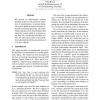119 search results - page 3 / 24 » Learning dialog act processing |
101
Voted
CORR
1998
Springer
15 years 3 days ago
1998
Springer
In this paper, we present a method for identifying discourse marker usage in spontaneous speech based on machine learning. Discourse markers are denoted by special POS tags, and t...
99
Voted
ICASSP
2010
IEEE
15 years 19 days ago
2010
IEEE
Automatic segmentation and classification of dialog acts (DAs; e.g., statements versus questions) is important for spoken language understanding (SLU). While most systems have re...
96
Voted
IALP
2009
14 years 10 months ago
2009
Automatic recognition of Dialog-act (DA) is one of the most important processes in understanding spontaneous dialog. Most existing studies have been working on how to use various ...
105
click to vote
EACL
2006
ACL Anthology
15 years 1 months ago
2006
ACL Anthology
We present an implemented machine learning system for the automatic detection of nonreferential it in spoken dialog. The system builds on shallow features extracted from dialog tr...
124
click to vote
EMNLP
2008
15 years 1 months ago
2008
We introduce the relative rank differential statistic which is a non-parametric approach to document and dialog analysis based on word frequency rank-statistics. We also present a...


